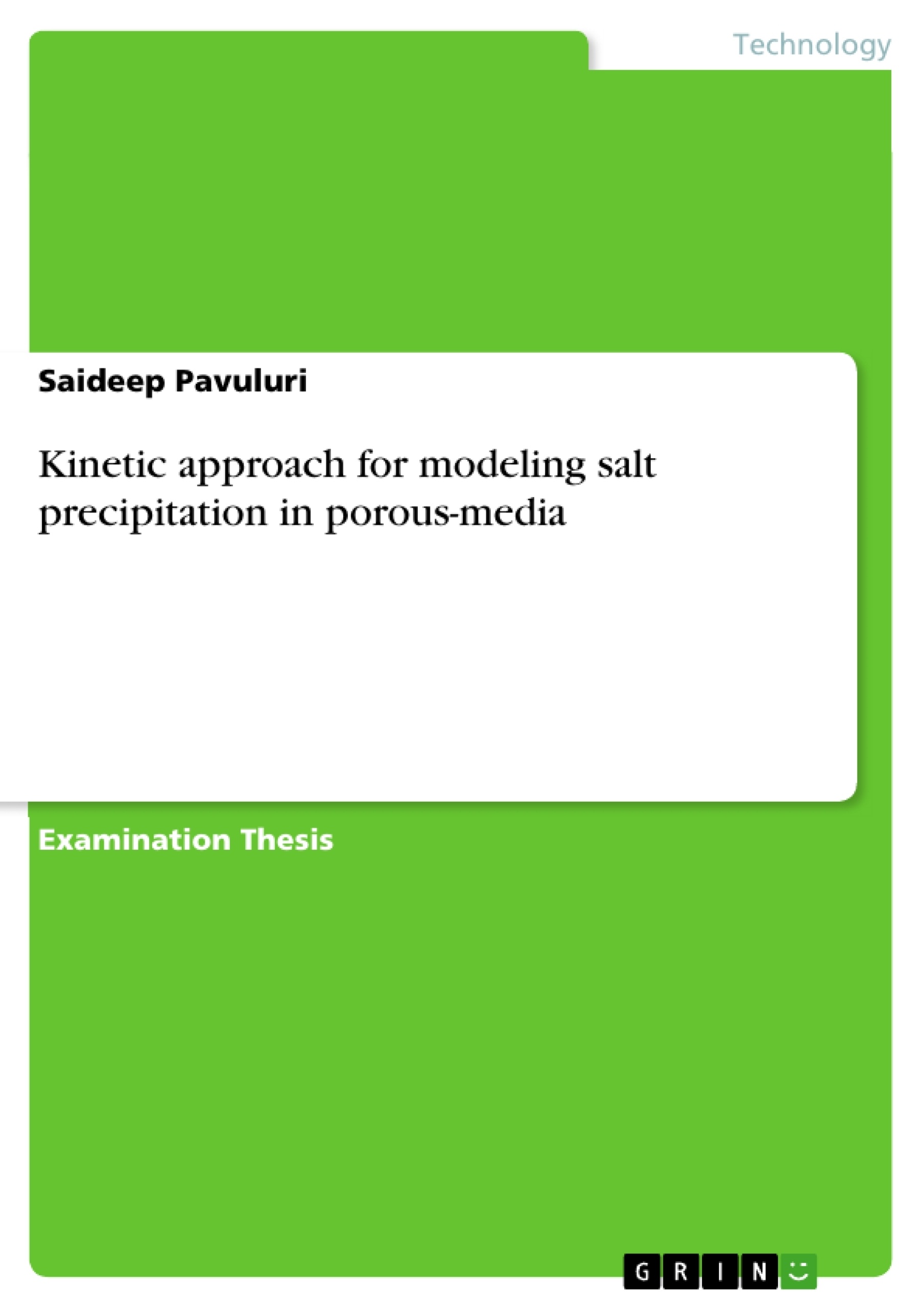Sail salinization had been an age old problem happening over decades and causing a serious concern to the environment. In this research for the first time a model had been developed to showcase the salt precipitation process within the porous medium using a "Kinematic approach".
Based over the defined formula, several parameter estimates were made and the results were analyzed accordingly.
In future, the model will be further developed with the implementation with a free flow domain considering real time parameters such as wind velocity, humidity, shear forces etc.
Apart from that the features of heterogeneities and other features to relate to a real life problem will be done.
Inhaltsverzeichnis (Table of Contents)
- Introduction
- Motivation
- Description of the process
- Structure of study
- Fundamentals
- Porous medium:
- Flow in the porous medium:
- Multiphase flow in the porous medium:
- Multiphase fluid velocity:
- Hydrodynamic dispersion:
- General mass balance for multiphase flow systems:
- Chemistry
- Description of Brine:
- Important chemical definitions:
- Porous medium:
- Model Concept
- Main aspects:
- Thermodynamic equilibrium
- Mass transfer between the phases:
- Fluid - Fluid Phases:
- Fluid Phase - Solid Phase:
- Transport Equations
- Energy balance equation
- Mass balance equations.
- Mass balance for the precipitated NaCl
- Source, Sink terms for the model
- Supplementary equations
- Constitutive relationships
- Primary variables
- Numerical Discretization
- Spatial Discretization:
- Time Discretization:
- Solution of the discretized equations:
- Results
- Scenario setup:
- Scenario 1: Decoupled model - Isothermal case
- Results and Discussions:
- Scenario 2: Decoupled model - Non-isothermal case
- Scenario setup
- Results and Discussions:
- Scenario 3: Comparison of the kinetic approach with the equilibrium approach.
- Summary
- Summary
- Future work
- A Values of the parameters used for simulation.
- Brooks and Corey parameters.
- Debye Huckel constant values
- Debye Huckel constant values
- Truesdell and Jones constants
Zielsetzung und Themenschwerpunkte (Objectives and Key Themes)
This independent study investigates the precipitation of salt in porous media through a kinetic approach. The study aims to develop a model that can accurately predict the distribution of salt in the medium, considering the effects of various factors such as flow, temperature, and chemical interactions. The study intends to provide a practical tool for understanding and managing salt precipitation problems in various environmental and engineering applications.
- Kinetic modeling of salt precipitation in porous media
- Multiphase flow and transport phenomena in porous media
- Thermodynamic equilibrium and mass transfer between phases
- Numerical simulation and analysis of salt precipitation
- Comparison of kinetic and equilibrium approaches to salt precipitation modeling
Zusammenfassung der Kapitel (Chapter Summaries)
- Introduction: This chapter introduces the motivation behind this study, focusing on the problem of salt precipitation in porous media and its relevance to various applications. It provides a general overview of the problem and describes the process of salt precipitation in porous media. Finally, it outlines the structure of the study.
- Fundamentals: This chapter establishes the fundamental concepts and equations governing fluid flow and transport in porous media. It introduces the concept of multiphase flow, hydrodynamic dispersion, and mass balance equations. It also delves into the chemistry of brine and discusses important chemical definitions relevant to the study.
- Model Concept: This chapter presents the core model concept, describing the key aspects of the kinetic approach to salt precipitation modeling. It explains the principles of thermodynamic equilibrium and mass transfer between different phases. The chapter further details the transport equations for energy, mass, and the precipitated salt. It also discusses the source and sink terms for the model, supplementary equations, constitutive relationships, and primary variables.
- Numerical Discretization: This chapter focuses on the numerical methods used to solve the model equations. It discusses spatial and time discretization techniques employed for the numerical solution of the model.
- Results: This chapter presents and discusses the simulation results obtained from the model. It analyzes various scenarios, including isothermal and non-isothermal cases, and compares the results of the kinetic approach with the equilibrium approach.
Schlüsselwörter (Keywords)
This study focuses on the kinetics of salt precipitation in porous media. It delves into the complexities of multiphase flow and transport phenomena in porous media, employing numerical methods for simulation and analysis. The study highlights the significance of thermodynamic equilibrium and mass transfer between phases, especially in the context of salt precipitation. Furthermore, it investigates the application of both kinetic and equilibrium approaches for modeling salt precipitation and compares their effectiveness. This research contributes to the understanding and management of salt precipitation problems in various practical contexts, such as soil salinization and groundwater contamination.
- Arbeit zitieren
- Saideep Pavuluri (Autor:in), 2014, Kinetic approach for modeling salt precipitation in porous-media, München, GRIN Verlag, https://www.hausarbeiten.de/document/277609


